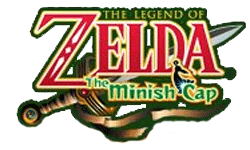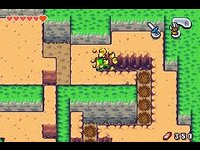|
|

|
BATTLE SYSTEM
|

|
INTERACTION
|

|
ORIGINALITY
|

|
STORY
|

|
MUSIC & SOUND
|

|
VISUALS
|

|
CHALLENGE
|
Easy
|
COMPLETION TIME
|
10-15 Hours
|
|
OVERALL
3.0/5
|
Rating definitions
|
|
|
Legend of Zelda titles tend to carry certain traditions – like bombs, boomerangs, and Octoroks – and they also reuse certain elements that are not found in nearly every game of the series – like familiar bits of music and sound effects. The Minish Cap, a Capcom-developed Game Boy Advance title, is an amalgamation of many Zelda elements, moreso than any previous incarnation in the series. There are also a few new fresh ideas. Unfortunately, the game also has its shortcomings.
As one can expect, The Minish Cap has plenty of sword-swinging action. In accordance with Zelda tradition, Link has an arsenal of wacky gadgets to assist him in his dungeon-crawling monster-hacking hijinks. There are the familiar staples – bombs, a bow and arrow, the boomerang, and Pegasus Boots – along with the new tools, which are creative and fun to use. The Gust Jar, for example, sucks up air and objects then spits them back out, Kirby style. Waving the Cane of Pacci causes almost anything to flip over, making this bizarre rod a hit at Hylian parties and an asset in dungeons with odd obstacles.
Some Zelda titles have some twist to their gameplay. In Ocarina of Time, Link traveled between two time periods, and in Majora's Mask, he had only three repeatable days to save the world. In The Minish Cap, Link journeys through Hyrule in two fun sizes: regular and miniscule. Shrinking down means gaining access to special items and solutions to puzzles, and it usually leads to interesting circumstances as well. It's a fun and unique aspect of the game.
 There are no Power Fruits in Hyrule, Link.
There are no Power Fruits in Hyrule, Link.
|
|
Just why is Link shrinking down? The simple and short answer is to save Hyrule, as usual. The long answer is that a mischievous villain has turned Princess Zelda to stone, and a wizard has offered to help by bringing Link down to the level of the Picori, the tiny magical folk of Hyrule who can repair the mystical blade that will bring justice and peace to the land. However, the wizard was turned into a green hat, so Link must wear the cantankerous cap and heed its snappy advice. It seems like a decent story, but it isn't. Zelda titles are not known for their complex, gripping storylines, but the tale of The Minish Cap does not even come close to the eye-opening twist in Link's Awakening or the pressing apocalyptic ambiance of Majora's Mask. While the cap-wizard has plenty of humorous lines, very little else in the game's story evokes emotion or even interest.
The most noticeable amalgamation in The Minish Cap is its visual style, which heavily borrows from Wind Waker. The cartoon style works very well with the 2D graphics, creating a simple, colorful, and charming world. The visuals also hearken back to Link to the Past, even though they do not strongly imitate that title. It isn't as visually impressive as Kingdom Hearts: Chain of Memories, but it's still well done.
 Link and Ezlo discover the mushrooms the makers of Earthbound were on.
Link and Ezlo discover the mushrooms the makers of Earthbound were on.
|
|
The sound of The Minish Cap is a blend of remixes of classic Zelda tunes and new music, plus many recycled sound effects and some revamped classic bits. Some of the remixes are pleasant and nostalgic, such as the reincarnated dungeon theme from Link to the Past, but a few are quite mediocre, like the tune that plays inside houses. Unfortunately, the new music is mediocre as well; for example, the mini-boss tune sounds like a pitiful parody of the "Psycho" theme. The only outstanding piece is the boss music, a finger-tapping tune that compels the player to keep up the pace in battle. Many sound effects are recycled from other Zelda games, notably Link's Awakening, and the game also uses voice clips from Ocarina of Time and Wind Waker, slightly garbled thanks to the power of the Game Boy Advance. One pleasant surprise, however, is that the flute plays the same tune as the flute in the first Legend of Zelda, only with smoother, modern sound.
The interface is also a conglomeration of old and new. It resembles that of Link's Awakening in the sense that any item may be set to either the A or B button. It has also been updated to allow the use of the shoulder buttons – both an asset and a hindrance. L and R navigate the item and map menus, and in the field, the R button function changes depending on the situation. While standing near a jar, for example, it changes to "Lift," and near an NPC it becomes "Talk." This way, the player doesn't accidentally fire an arrow when he or she means to pick up a jar or set a bomb instead of talking to someone. Unfortunately, the R button also makes Link perform a forward roll. If he isn't properly positioned near a jar the player wants to pick up, he will somersault forward, sometimes hurling himself into the nearest bottomless pit.
The Minish Cap is not difficult, although there are a few bosses and puzzles that surprise the player with a slight challenge. It's no more difficult than any other Zelda title, and it's most likely the easiest one to date.
The great drawback to the game, however, is its length. Maybe Capcom and Nintendo intended to make a corny pun about having a game in which Link becomes incredibly short be an incredibly short game itself, but players won't be laughing at that gag. The Minish Cap has only five dungeons. Without the three-day do-it-again challenge of Majora's Mask, a game with only four major dungeons, The Minish Cap comes up short. Forgive the pun. Instead of having more dungeons, the rest of the game consists of filler sidequests.
The Minish Cap certainly has its assets: solid visuals, plenty of nostalgia, and creative new gadgets. It also has some serious drawbacks, namely the interface and length, but neither should keep players away from the game.
Review Archives
|









